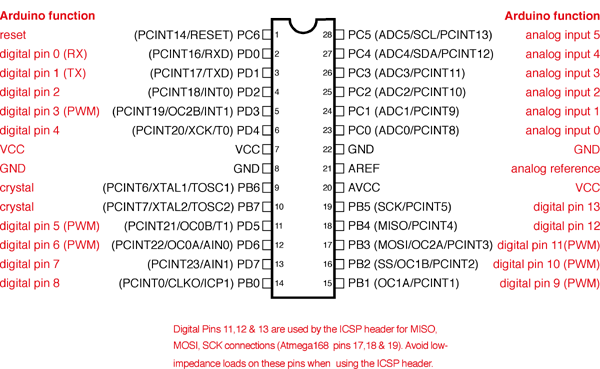So, you have just made an awesome gadget using an Arduino. You love it. OH! wait, you just got another idea for a different great project! But then.. you have to take your old one apart.. Is there a way to have more than one Arduino project without having more than one Arduino?
Yes, by putting you project on a bread board, you can accomplish this task, as well as saving some coin and earning the bragging rights of building it yourself. The video above explains about how to do that. An Atmel ATmega328 IC will serve you greatly. All that is needed is the ATmega IC and a few external components, a crystal, a few ceramic caps, and an FTDI Friend or FTDI Cable interface.
The purpose of doing this is so you can develop more than one project at a time without having to buy additional Arduino’s, and the second is to test a circuit for production. Remember, and Arduino has a lot of handy circuitry on it that you might not want on your project. For example, you might not need power switching, ICSP header, or FTDI/8U2 circuitry. Transferring your project to a breadboard will allow you to see how your project will run with the ‘bare essentials’.
The circuit is surprisingly simple, so if you haven’t tried it, build a stand alone project. Adafruit even has great Arduino stickers so you can quickly and easily identify the pins. Below is a pin reference image. Happy building, it’s a lot of fun!
Arduino Sketch (.pde file – 1.0 and 22 compliant)


I’m not sure what an Arduino is exactly, but that looks like fun!
Arduino’s are very fun and easy to use since there’s so many people using them. Basically anything you ever wanted to do with them you can find a tutorial on. I also found some nice breadboards that look exactly like those at nordevx.com
This is a thorough explanation of the atmega328 circuit, it’s much simpler than I thought. What value capacitors are you using from the crystal to ground?
Thanks!
aisen
Hi! The cap values are 22pF.
Hi.
Thanks for the very informative tutorial.
I didn’t quite catch whether you said uploading a sketch onto the ATMega on the breadboard was with or without the Arduino bootloader.
I’ve created a nice project on the Arduino Duemilanove and prized out the Mega chip and put it straight onto my protoboard from Protostack. There’s power to VCC on the chip but the firmware doesn’t run. I suspect I’m doing something very wrong with having the Arduino bootloader on the chip now placed in the protoboard.
Could you kindly let me know if I need an FTDI or external programmer to upload a sketch connected to the protoboard?
Kind regards,
Azhar
Hi Azhar! The 328 I use does have an Arduino bootloader on the 328. I use an Arduino bootloader, 16 MHz crystal connected to physical pins 9 and 10, two 22pF (one is connected to physical pin 9 and ground, the other is connected to physical pin 10 and ground), and 5V power on physical pin 7, and ground to physical pin 8. This gets a sketch running that was uploaded by an arduino, but to program it on the board you have to use an FTDI adaptor. This can be done with the Arduino IDE, it’s what I use all the time. The FTDI connections are as follows:
DTS: (or green) connected to physical pin 1 with a .1uF cap in series (auto reset)
RX: connected to physical pin 3 of the 328
TX: connected to physical pin 2 of the 328
5V: connected to power (physical pin 7 of the 328)
CTS: No connection
GND: – connected to ground (Physical pin 8 of the 328)
Hope this helps, let me know if you can’t get it working!